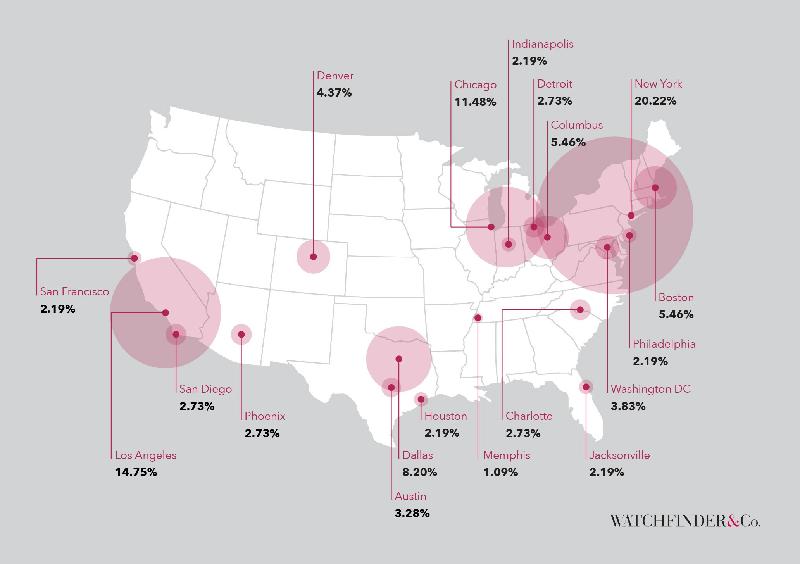Top Cities For Fake Watch Purchases: How can you tell if a Rolex is real?

An estimated 23.3 million fake watches circulating the US market alone. Map of the US detailing the top ten top cities where fake watches are in high circulation by Watchfinder & Co.; @ Watchfinder
New research released this week reveals there are an estimated 23.3 million fake watches circulating the US market alone1, according to a study by luxury pre-owned watch specialist, Watchfinder & Co. Additionally, of all the luxury watches sent to Watchfinder over the last year, at least half of those identified as fake or containing fake parts were Rolex.
In a shocking revelation, luxury pre-owned watch specialist, Watchfinder & Co., has uncovered a disconcerting reality: an estimated 23.3 million fake watches are currently circulating in the US market alone. The implications of this staggering number extend beyond mere counterfeits; they delve into the very fabric of trust within the luxury watch industry.
The Alarming Statistics: Unmasking the Proliferation
Watchfinder’s recent study not only sheds light on the prevalence of fake watches but also highlights the unnerving fact that half of the luxury watches identified as fake or containing counterfeit parts over the past year were Rolex timepieces. With almost a quarter of consumers falling victim to purchasing fake items and nearly one in ten Americans deceived into acquiring a fake watch, the magnitude of this issue cannot be understated.
Digging deeper, the research identifies the top cities where fake watches thrive. The Big Apple leads the pack with 20.22%, followed by Los Angeles (14.75%) and Chicago (11.48%). The very cities renowned for their discerning taste in luxury goods are unwittingly hosting a thriving market for counterfeit timepieces.
Watchfinder’s Call to Action: Shopping Smart in a Sea of Fakes
In response to this alarming trend, Watchfinder is sounding the alarm and urging consumers to “shop smart.” The surge in counterfeit watches, including the emergence of ‘super fakes,’ has prompted the pre-owned watch specialist to call for transparency in the industry. Watchfinder challenges pre-owned traders, retailers, and marketplaces to publicly declare their authentication policies, processes, and credentials, aiming to restore trust in a sector clouded by counterfeit cowboys.
The research indicates that 59% of respondents find it challenging to purchase legitimate designer items beyond dedicated brand retailers. As the counterfeit market continues to grow, discerning buyers face an uphill battle in distinguishing genuine luxury from deceptive replicas.
The Rise of Super Fakes: A Technological Challenge
Watches now account for almost 20% of all counterfeit sales, a statistic that reflects both the demand for luxury timepieces and the industry’s vulnerability to counterfeiters. The rise of ‘super fakes,’ facilitated by advancements in technology such as 3D printers and CNC machines, poses a significant challenge. Watchfinder notes that around five years ago, 80% of counterfeit watches were easily identifiable at first glance. Today, a staggering 80% are classified as ‘super fakes,’ requiring closer scrutiny.
Despite the visual resemblance, the research emphasizes that the technological and functional prowess of genuine timepieces cannot be replicated. Approximately 15% of fake watches broke after minimal usage, underscoring the inferior quality of counterfeit imitations.
Spotting the Fakes: Types of Counterfeits and Warning Signs
Watchfinder identifies three types of fake watches to watch out for:
- Completely Fake Watches: The most straightforward counterfeit, where the entire watch is a fake imitation.
Watches with Partially Fake Parts: Legitimate watches with fake components presented as wholly authentic. - Frankenwatches: Comprising parts from different watches of the same type, these accounted for 21% of fake watches purchased in the US.
Spotting a fake Rolex or any luxury watch requires a keen eye and knowledge. To raise awareness, Watchfinder has launched an interactive game challenging consumers to differentiate between real and fake watches, guiding them through factors like rehaut, pins, bezel, printing, and engraving.
Watchfinder’s Commitment to Authenticity: A Zero Tolerance Policy
Arjen van de Vall, CEO of Watchfinder & Co., emphasizes the brand’s commitment to authenticity with a zero-tolerance policy on counterfeits. Every watch undergoes a rigorous 60-step inspection and authentication process at one of Watchfinder’s service centers. Accredited by 19 different luxury watch manufacturers, Watchfinder sets the industry standard for authentication, ensuring that every timepiece sold is 100% authentic.
In a bid to eradicate counterfeits and restore consumer faith, Watchfinder invites other pre-owned watch traders, retailers, and marketplaces to join their campaign for transparency and accountability. While this call to action benefits Watchfinder, the underlying motive is to elevate the entire industry, safeguarding it from the shadow cast by counterfeit cowboys.

